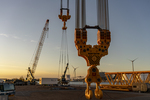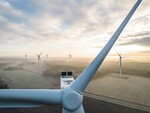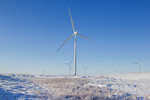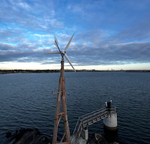10/11/2010
Africa - Exploring Wind Energy as the Solution to Africa's Energy Shortages
In a recent survey conducted by the International Quality and Productivity Centre (IQPC), 64.28% of the 2,754 energy sector respondents have chosen wind power as the principle solution to meet Africa's growing energy demand. This topic will be further explored at IQPC's Wind Power Development and Implementation conference, taking place in Cairo, Egypt from 12-15 December 2010.
The continent has seen a rapid increase in renewable energy projects to supply energy needs. Africa not only faces electricity shortages but also consistent and lengthy power cuts. Earlier this year the Egyptian Electricity Ministry had to ration out national power by inducing power outages as a direct result of higher electricity consumption. For a country without oil reserves, renewable energy becomes an even bigger necessity.
The Moroccan government has ambitious plans to have installed 2000 MW of wind energy by 2020. Morocco's King Mohammed VI inaugurated a 250 million euro (300 million dollar) wind farm near Tangiers, which is currently the biggest in Africa.
However, Kenya is also competing to open Africa's biggest wind farm and is back in the running following a government guarantee for financing the Lake Turkana Wind Power Project, which plans to produce 300 MW and 300 wind turbines in Marsabit.
Egypt plans to launch its first privately owned wind farm in 2013 under an ambitious climate change strategy that includes producing a fifth of its power from renewable energy sources by 2020.
Trading fossil fuels for greener energy like solar, wind and water helps curb the carbon emissions that are heating up the planet. Global warming is expected to bring higher sea levels and more extreme weather, putting the world's food and water supplies at risk.
Rising seas are a looming threat in Egypt, where over half the population lives within 100 km (62 miles) of the Nile River coastline. Officials say 6 to 8 million people could be displaced and nearly half the country's crops, which are grown along the Nile Delta, submerged.
The wind farm - expected to produce 250 megawatts (MW) of power - will be located in the Gulf of Suez along the Red Sea, regarded as one of the world's best wind energy sites, with wind speeds of up to 11 metres per second. Ten local and foreign companies have been shortlisted for the scheme, which is expected to come online by the end of 2013.
"The Gulf of Suez is an excellent area for wind farms. Several projects are under way to create more wind parks there, which could have capacity of around 2,000 MW," said Mohab Hallouda, a senior energy specialist at the World Bank.
In June, the bank loaned Egypt $220 million to develop wind power, which will help the country meet its 20 percent renewable energy target. Two fifths of that will come from hydropower generation and the rest from solar and wind.
Hallouda said the loan, which is mostly from the World Bank's Clean Technology Fund (CTF), will help finance a transmission line to transfer the electricity produced by the wind farms to the country's power grid.
The CTF was set up in 2008 by donor nations which pledged about $5 billion to kick start large, risky investments in clean technology in developing countries ahead of a new global deal to tackle climate change.
Egypt's push on renewable energy could not be more timely, as electricity demand in the Arab world's most populous country is increasing at around six percent each year.
The country experienced consistent power outages - the worst in decades - during the last few weeks of summer as temperatures hit 40 degrees Celsius. The blackouts provoked public anger, which had already been on the rise over increasing living costs. Nearly a fifth of Egypt's population of close to 82 million lives on less than $2 a day.
Government officials blamed the power outages on increased consumption in the peak summer season, and have vowed to boost power capacity.
Egypt already has publicly owned wind farms in the Zafarana area, south of the Gulf of Suez, with a capacity of 520 MW, as well as a small research and development wind park in Hurghada, further south along the Red Sea.
But so far the electricity generated from existing wind farms accounts for only around two percent of the country's total installed power capacity of approximately 25 gigawatts (GW). Most of Egypt's electricity - around 85 percent - comes from thermal power stations, which are mainly fueled by natural gas.
According to Egypt's latest national report to the United Nations, issued in May, it produced 193 million tonnes of greenhouse gases in 2000 - a figure forecast to increase by about five percent annually.
The electricity ministry says it hopes to scale up its wind energy capacity to around 7,200 MW by 2020, thereby reducing carbon emissions by about 17 million tonnes per year from what they would have been otherwise.
According to Egypt's New and Renewable Energy Authority (NREA), wind power saved the country around half a million tonnes of carbon emissions in 2008-2009.
The government plans to build more wind farms on the east and west banks of the Nile River, some with private investment, possibly from Japanese companies.
Cairo is also looking at developing other renewables such as solar. It is setting up a solar-thermal power plant in the Kuraymat area, south of the capital Cairo, which will start operating at the end of this year.
The project is financed by a $50 million grant from the Global Environmental Facility, an international funding body. Egypt applied for the funds through the World Bank.
But the cost of building wind and solar power stations - higher than for hydro or thermal plants - remains a major obstacle to renewable energy schemes. So far, Egypt's wind farms have been made possible through soft loans from various countries.
"Thermal-powered stations that use liquid or natural gas as fuels can operate up to 90 percent of the time, whereas wind farms work between 35 and 45 percent (of the time) throughout the year, and depend on the availability of wind, its speed and continuity," said the World Bank's Hallouda.
"That's why many countries seek more thermal-powered stations than wind or solar, especially developing countries - including Egypt - where the electricity bills comprise a huge percent of (people's) monthly income," he added.
Hallouda said an effective way to make wind and solar energy cheaper is to build more green power plants, bringing down construction costs.
The Global Wind Energy Council has predicted global installed wind capacity to reach 200 GW by the end of 2010. Steve Sawyer, Secretary General of the GWEC, says: 'As wind power is becoming more competitive, it is rapidly expanding beyond the traditional markets in North America and Europe. In fact, around half of the growth is now happening in emerging economies and developing countries.'
Key speakers at Wind power Development and Implementation include Eskom's Chief Engineer, Riaan Smit; Senior Investment Officer/Energy Expert of the African Development Bank, Youssef Arfaoui; Egyptian Environmental Affairs Agency's General Director of Energy Projects, Dr. Hisham El Agamawy and KenGen's Chief Engineer, Christopher Maende.
Wind Power Development and Implementation conference has been designed to provide an insight into the practical and technical issues surrounding wind farm projects. Through detailed presentations, interactive panel discussions, case studies and two extensive workshop days this event will tackle key challenges faced when developing a commercially viable wind farm.
For more information on this article or if you would like to know more about what www.windfair.net can offer, please do not hesitate to contact Trevor Sievert at ts@windfair.net
www.windfair.net is the largest international B2B Internet platform – ultimately designed for connecting wind energy enthusiasts and companies across the globe!
The continent has seen a rapid increase in renewable energy projects to supply energy needs. Africa not only faces electricity shortages but also consistent and lengthy power cuts. Earlier this year the Egyptian Electricity Ministry had to ration out national power by inducing power outages as a direct result of higher electricity consumption. For a country without oil reserves, renewable energy becomes an even bigger necessity.
The Moroccan government has ambitious plans to have installed 2000 MW of wind energy by 2020. Morocco's King Mohammed VI inaugurated a 250 million euro (300 million dollar) wind farm near Tangiers, which is currently the biggest in Africa.
However, Kenya is also competing to open Africa's biggest wind farm and is back in the running following a government guarantee for financing the Lake Turkana Wind Power Project, which plans to produce 300 MW and 300 wind turbines in Marsabit.
Egypt plans to launch its first privately owned wind farm in 2013 under an ambitious climate change strategy that includes producing a fifth of its power from renewable energy sources by 2020.
Trading fossil fuels for greener energy like solar, wind and water helps curb the carbon emissions that are heating up the planet. Global warming is expected to bring higher sea levels and more extreme weather, putting the world's food and water supplies at risk.
Rising seas are a looming threat in Egypt, where over half the population lives within 100 km (62 miles) of the Nile River coastline. Officials say 6 to 8 million people could be displaced and nearly half the country's crops, which are grown along the Nile Delta, submerged.
The wind farm - expected to produce 250 megawatts (MW) of power - will be located in the Gulf of Suez along the Red Sea, regarded as one of the world's best wind energy sites, with wind speeds of up to 11 metres per second. Ten local and foreign companies have been shortlisted for the scheme, which is expected to come online by the end of 2013.
"The Gulf of Suez is an excellent area for wind farms. Several projects are under way to create more wind parks there, which could have capacity of around 2,000 MW," said Mohab Hallouda, a senior energy specialist at the World Bank.
In June, the bank loaned Egypt $220 million to develop wind power, which will help the country meet its 20 percent renewable energy target. Two fifths of that will come from hydropower generation and the rest from solar and wind.
Hallouda said the loan, which is mostly from the World Bank's Clean Technology Fund (CTF), will help finance a transmission line to transfer the electricity produced by the wind farms to the country's power grid.
The CTF was set up in 2008 by donor nations which pledged about $5 billion to kick start large, risky investments in clean technology in developing countries ahead of a new global deal to tackle climate change.
Egypt's push on renewable energy could not be more timely, as electricity demand in the Arab world's most populous country is increasing at around six percent each year.
The country experienced consistent power outages - the worst in decades - during the last few weeks of summer as temperatures hit 40 degrees Celsius. The blackouts provoked public anger, which had already been on the rise over increasing living costs. Nearly a fifth of Egypt's population of close to 82 million lives on less than $2 a day.
Government officials blamed the power outages on increased consumption in the peak summer season, and have vowed to boost power capacity.
Egypt already has publicly owned wind farms in the Zafarana area, south of the Gulf of Suez, with a capacity of 520 MW, as well as a small research and development wind park in Hurghada, further south along the Red Sea.
But so far the electricity generated from existing wind farms accounts for only around two percent of the country's total installed power capacity of approximately 25 gigawatts (GW). Most of Egypt's electricity - around 85 percent - comes from thermal power stations, which are mainly fueled by natural gas.
According to Egypt's latest national report to the United Nations, issued in May, it produced 193 million tonnes of greenhouse gases in 2000 - a figure forecast to increase by about five percent annually.
The electricity ministry says it hopes to scale up its wind energy capacity to around 7,200 MW by 2020, thereby reducing carbon emissions by about 17 million tonnes per year from what they would have been otherwise.
According to Egypt's New and Renewable Energy Authority (NREA), wind power saved the country around half a million tonnes of carbon emissions in 2008-2009.
The government plans to build more wind farms on the east and west banks of the Nile River, some with private investment, possibly from Japanese companies.
Cairo is also looking at developing other renewables such as solar. It is setting up a solar-thermal power plant in the Kuraymat area, south of the capital Cairo, which will start operating at the end of this year.
The project is financed by a $50 million grant from the Global Environmental Facility, an international funding body. Egypt applied for the funds through the World Bank.
But the cost of building wind and solar power stations - higher than for hydro or thermal plants - remains a major obstacle to renewable energy schemes. So far, Egypt's wind farms have been made possible through soft loans from various countries.
"Thermal-powered stations that use liquid or natural gas as fuels can operate up to 90 percent of the time, whereas wind farms work between 35 and 45 percent (of the time) throughout the year, and depend on the availability of wind, its speed and continuity," said the World Bank's Hallouda.
"That's why many countries seek more thermal-powered stations than wind or solar, especially developing countries - including Egypt - where the electricity bills comprise a huge percent of (people's) monthly income," he added.
Hallouda said an effective way to make wind and solar energy cheaper is to build more green power plants, bringing down construction costs.
The Global Wind Energy Council has predicted global installed wind capacity to reach 200 GW by the end of 2010. Steve Sawyer, Secretary General of the GWEC, says: 'As wind power is becoming more competitive, it is rapidly expanding beyond the traditional markets in North America and Europe. In fact, around half of the growth is now happening in emerging economies and developing countries.'
Key speakers at Wind power Development and Implementation include Eskom's Chief Engineer, Riaan Smit; Senior Investment Officer/Energy Expert of the African Development Bank, Youssef Arfaoui; Egyptian Environmental Affairs Agency's General Director of Energy Projects, Dr. Hisham El Agamawy and KenGen's Chief Engineer, Christopher Maende.
Wind Power Development and Implementation conference has been designed to provide an insight into the practical and technical issues surrounding wind farm projects. Through detailed presentations, interactive panel discussions, case studies and two extensive workshop days this event will tackle key challenges faced when developing a commercially viable wind farm.
For more information on this article or if you would like to know more about what www.windfair.net can offer, please do not hesitate to contact Trevor Sievert at ts@windfair.net
www.windfair.net is the largest international B2B Internet platform – ultimately designed for connecting wind energy enthusiasts and companies across the globe!
- Source:
- Online Editorial, www.windfair.net
- Author:
- Posted by Trevor Sievert, Online Editorial Journalist
- Email:
- ts@windfair.net
- Link:
- www.windfair.net/...
- Keywords:
- wind energy, wind power, wind turbine, onshore, offshore, windmill, www.windfair.net, Trevor Sievert, ECA


























